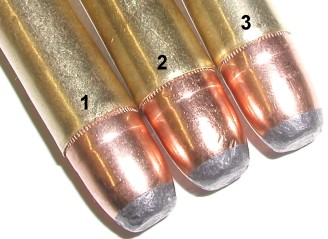 I was writing the article “Tools for .45-70 handload development”, extolling the virtues of crimping, when I began to wonder if, in fact, crimping mattered at all. Handloaders do a lot of things habitually, and often don’t stop to ask the basic question, “Why the heck am I doing this?” Outside of the perfectly valid response, “Because it gives me a reason to buy more tools”, a better practical reason might not be so obvious. The seating die for the .45-70, handles roll crimping and bullet seating, and Lee makes a Factory Crimp die. #1 no crimp, #2 RCBS seating die roll crimp, #3 Lee Factory Crimp Die.
I was writing the article “Tools for .45-70 handload development”, extolling the virtues of crimping, when I began to wonder if, in fact, crimping mattered at all. Handloaders do a lot of things habitually, and often don’t stop to ask the basic question, “Why the heck am I doing this?” Outside of the perfectly valid response, “Because it gives me a reason to buy more tools”, a better practical reason might not be so obvious. The seating die for the .45-70, handles roll crimping and bullet seating, and Lee makes a Factory Crimp die. #1 no crimp, #2 RCBS seating die roll crimp, #3 Lee Factory Crimp Die.
On one hand, I can offer into evidence for the crimp or die crowd, there are many tons of bullets that have been produced with those little circumferential rings. There are even spiffy little tools for those of who were unfortunate enough to buy bullets without cannelures, and would like to correct their bullet cannelure deficiencies by manually coining the little grooves into smooth bullet jacket surfaces. I saw a recent article where the bullet owner actually paid a machinist to cut into perfectly good jacket material, no doubt so other cannelured bullet owners wouldn’t hold him up in ridicule. Yup, there must be a serious and significant reason for crimping if people went to these extremes to make sure they had the ability to form them. So I set off to try to develop a better understanding of the state of modern day crimpiness which, at the very least, would get me out of some household chores for an hour or two.
Crimping seems to accomplish a couple of things
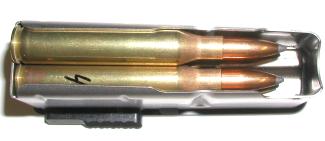 The Remington Mountain rifle mag (left) is not from a boomer, but the space ahead of the cartridges, and the position of the forward wall of the magazine illustrate the mechanics of a problem frequently stated as a reason for crimping. Cartridges held in the magazine of a big boomer tend to get smacked around every time the rifle is discharged. Because the cartridges residing in magazines are not actually fixed to the rifle, during recoil they tend to “float”, or remain in place, while the rest of the rifle moves sharply rearward. Unfortunately, the parts fixed to the rifle, and located directly forward of these stored cartridges, are typically made of some hard stuff that tends to move sharply rearward under recoil, potentially striking the tips of the cartridges. At least that’s the crimpers mantra. If the bullet was driven back into the case, powder could spill all over the place and jam the gun on attempted firing, or cause unplanned powder compression that could lead to barrel blowing pressure spikes. The explanations are always capped off with, “and if you were elephant or bear hunting, crimping could have save your life”. Whew, pretty scary stuff.
The Remington Mountain rifle mag (left) is not from a boomer, but the space ahead of the cartridges, and the position of the forward wall of the magazine illustrate the mechanics of a problem frequently stated as a reason for crimping. Cartridges held in the magazine of a big boomer tend to get smacked around every time the rifle is discharged. Because the cartridges residing in magazines are not actually fixed to the rifle, during recoil they tend to “float”, or remain in place, while the rest of the rifle moves sharply rearward. Unfortunately, the parts fixed to the rifle, and located directly forward of these stored cartridges, are typically made of some hard stuff that tends to move sharply rearward under recoil, potentially striking the tips of the cartridges. At least that’s the crimpers mantra. If the bullet was driven back into the case, powder could spill all over the place and jam the gun on attempted firing, or cause unplanned powder compression that could lead to barrel blowing pressure spikes. The explanations are always capped off with, “and if you were elephant or bear hunting, crimping could have save your life”. Whew, pretty scary stuff.
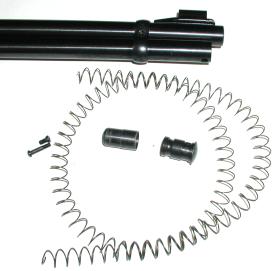 A similar dynamic, attributed to rifles with tubular magazines that are chambered for heavy recoil causing cartridges is somewhat more dubious. The concern is that forward stowed cartridges will slam rearward into other stowed cartridges, and drive the bullets into cartridge cases. Subsequently there is a recommendation that cartridges for this type of application also be crimped.
A similar dynamic, attributed to rifles with tubular magazines that are chambered for heavy recoil causing cartridges is somewhat more dubious. The concern is that forward stowed cartridges will slam rearward into other stowed cartridges, and drive the bullets into cartridge cases. Subsequently there is a recommendation that cartridges for this type of application also be crimped.
The Marlin lever gun, pictured on the right, has a plug that resides in the magazine and, under considerable spring pressure, is loaded against the cartridges in the magazine. A second plug acts as a spring end cap to the magazine tube. When the gun is fired, all cartridges attempt to remain in place together, so one would not slam rearward into the other, and the spring dampened plug makes sure all cartridges pretty much follow in the direction of recoil.
Maybe of greater consequence
A second reason for crimping is uniformity of ignition; bullets are held more tightly than when no crimp is employed, so powder and bullet are not driven into the bore by the primer prior to ignition. This assures, or at least improves the chances, that the powder will be ignited within a chamber volume that is uniform from one cartridge to the next, and as anticipated by the load data. I can generally see this consistency with a chronograph when checking 350 grain bullet .45-70 round to round performance. At times, I can also find a gain of 20fps~25fps of velocity from cartridges crimped with the Lee Factory Crimp tool, compared to uncrimped cartridges. This may not seem like much, but the velocity difference is the equivalent of a half grain of Winchester 748 and approximately 1,200 PSI of chamber pressure. So crimping does alter something, even if only increasing pressure.
Crimping tools are serious business
If you think about it, regardless the manner of crimp, the only thing holding on is the brass, so it would seem no crimp could produce a grip any stronger than the yield strength of brass. I figured somewhere under the pile of junk I call my work shop, was something that could prove out my theories. There were two forces I assumed I needed to measure to properly value crimping. The first was compression resistance; how much force did it take to overcome the crimp and force the bullet rearward into the case. This is the protection a crimp affords against bullet being driven into the cartridge case under recoil or harsh handling. The second was resistance to extraction, or the force required to overcome the crimp and extract the bullet from the case. This is the protection the crimp affords in holding the bullet securely in place to assure consistent ignition and pressure.
Compression Yield
 One of my favorite sources for inexpensive non-critical shop tools is Enco. As an example, this 1 ton arbor press sells for about $28. I borrowed a 150 lb freight scale for the sake of accuracy, but I suppose I could have used a $20 digital bathroom scale. Combined, these two pieces of equipment made up my tester for measuring compression yield.
One of my favorite sources for inexpensive non-critical shop tools is Enco. As an example, this 1 ton arbor press sells for about $28. I borrowed a 150 lb freight scale for the sake of accuracy, but I suppose I could have used a $20 digital bathroom scale. Combined, these two pieces of equipment made up my tester for measuring compression yield.
The idea was to sandwich the test cartridge assemblies between the arbor press ram, and the scale, with the scale sitting on the base of the arbor press so it could not move downward as the ram moved. I planned to compress the case gradually, and track the peak pressure just before the bullet began to move into the case.
This is the part where I realized the project was going to be a lot more work, and a lot less interesting to set up than I originally anticipated. I needed three states of crimp; bullets seated after case resizing with no crimp, RCBS die induced roll crimped cases and
Using new cartridge brass and bullets, I decided I would produce and measure 10 examples of each type get something that could minimally pass for statistically supported results.
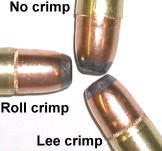 I used the term “no crimp” on the examples that relied only on neck tension to retain the bullet. The .45-70 is a nearly straight case, so full length resizing only applies pressure inward on the case, and there is no traditional bottle neck case expander button to pull back though the formed case to set proper case mouth diameter. The second die in a three die set, is the expander die. The expander die houses an anvil that properly expands the case for correct neck tension and, if desired, slightly bells the mouth to make bullet starting easier. The third die in the set seats the bullet, and offers the option of roll crimping the bullet case assembly, or seating and retaining the bullet with only case neck tension.
I used the term “no crimp” on the examples that relied only on neck tension to retain the bullet. The .45-70 is a nearly straight case, so full length resizing only applies pressure inward on the case, and there is no traditional bottle neck case expander button to pull back though the formed case to set proper case mouth diameter. The second die in a three die set, is the expander die. The expander die houses an anvil that properly expands the case for correct neck tension and, if desired, slightly bells the mouth to make bullet starting easier. The third die in the set seats the bullet, and offers the option of roll crimping the bullet case assembly, or seating and retaining the bullet with only case neck tension.
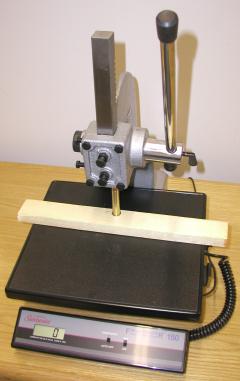
With newly formed Winchester brass, 405 grain Remington jacketed bullets and 10 each of the no crimp, roll crimp and factory crimp sample cartridges, I started leaning on powderless and primerless cartridge assemblies. I just moved slowly and monitored the scale reading for peak. As a bullet would break loose and begin to move inward, pressure would peak, drop slightly, then continue on requiring relatively uniform force until the case hit the bullet ogive, or curved area.
The cartridges without roll crimp withstood an average of 54 lbs of downward vertical force before the bullets became dislodged. I was surprised that much force was required, and, but I also noted this force could be exceeded with a strike during heavy recoil, but because the bullet would be working only against the cartridge’s inertia to put the cartridge also in motion, I think it would take more than recoil to shift a bullet in this situation. The variation in required force within these sample of less than 2 lbs.
The RCBS die roll crimp was a good step up in clamping force, I’m sure because the bullet would have to overcome the brass edge locked into the cannelure, and either collapse the brass, or force it outward to clear the top shoulder of the cannelure. 101 lbs of downward force were needed to push the bullet into the case and to defeat the shoulder of the cannelure. In short, with a proper roll crimp, the bullet wasn’t going anywhere rearward as a result of recoil, or under all but the most abusive handling. The Lee Factory Crimp tool consistently added another 21 lbs of required force to overcome its mechanical grip on the bullet, for an ability to resist an average of 122 lbs of downward force. Neat.
Force required to extract a bullet
Quantifying the force required to extract a bullet was a bit more difficult, at least for me, and without spending lots of money for specialized scales or making an elaborate test fixture. I like to accomplish these little projects with items that are pretty common around a shop or home, with the hope that someone bored into a stupor with TV reruns might become curious and want to try some of these little experiments on their own.
For openers, I stopped using inertial hammers some time ago, replacing them with a collet puller. The collet puller requires a lot less effort, and can pull the bullet without damage to it or the case, and without the risk of tossing powder all over the place after the pull. In regard to this project, It seemed this type of puller would line up with the vertical axis of the case, and permit a straight and measurable extraction while providing a place to affix a scale.

I needed a way to retain the cartridge case while tugging on the bullet, so I removed the Lock-N-Load bushings from my Rock Chucker press and collet puller, which allowed the shell holder to anchor the case on the press ram, while still being able to clamp the collet puller to the bullet and remain free to pass though the die port at the top of the press. Sensing this was coming together is some acceptable form, I then ran off ten more samples of each of the same types of crimps from the turret press, as used for the compression part of the test, which semi guaranteed there would be some consistency of assembly being measured.
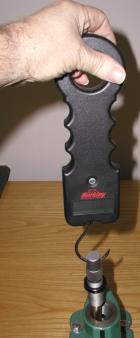
I selected for such critical measurement duties a bullet pull scale, that just happened to look like a 50 lb rated Berkley Digital Fish Scale, which is just like a trigger pull scale, only $28 from Cabela’s rather than $45 for a Lyman or RCBS digital trigger pull scale, or $70 for a gunsmith’s mechanical pull scale. The Berkley unit reads out in whole and tenths of a pound, and is moderately dampened to prevent the user from getting dizzy while observing escalating or declining readings. I sat my video camera on a nearby table to capture my star qualities, but also to capture the highest reading while tugging away at the seated bullet. I figured if I blinked as the numbers flashed by, I’d have to do this all over again.
The results were a little surprising but, fortunately, I had 10 readings from each sample type to validate findings, and there was no more than a 1~2 lb cartridge variation for any of bullet retaining methods. Full length resized brass, followed by a pass with an expander plug, and no crimp, required 37 lbs of pulling force to get the case to cough up a bullet. The RCBS roll crimp held up only to 28 lbs of extraction force. Unlike the compression force that pushed the cannelure shoulder over the edge of the roll crimp, pulling dragged the inside curved surface of the crimp over the lower edge of the cannelure which gave some mechanical advantage to opening the brass. I believe the Lee Factory Crimp tool reinforces this possibility.
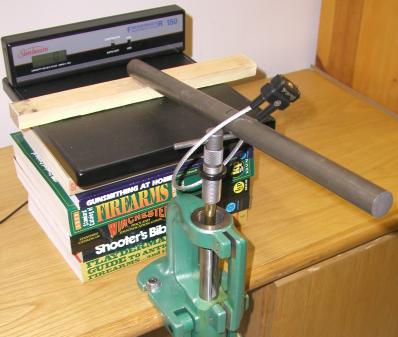
Now see, this is about where I left the amateur ranks and began building some very sophisticated measuring equipment. Sure, it may look like a freight scale sitting on top of a pile of books, and a Weatherby trigger lock with a steel bar passing through it, but…we’ll actually that’s exactly what it is.
So where does this leave me on the issue of crimps?
I believe, at least with rifle cartridges, normal full length sizing provides adequate neck tension to prevent bullets from being driven inward, with the exception of rifles that generate upwards of 70 ft lbs of recoil and have a magazine well; my .338-378, 358-378 and .416 Weatherby rifles. I will probably continue to crimp those handloads where the presence of cannelures permit. The Marlin Guide Gun can crank up some recoil, but I believe the spring balance of the tubular magazine more than off sets for the potential of recoil bashing rounds. While crimping does raise pressure and velocity, probably as a function of greater bullet clamping force, if the round to round velocity is uniform, it seems I can achieve the same velocity and pressure increase by bumping the charge, making crimping unnecessary. If I were to work with highly compressed charges and magnum primers, I might be tempted to roll crimp to prevent primer driven bullet creep prior to powder ignition, so I may crimp if I encounter that situation. I think little of this may apply to handguns, so I will reserve that judgment until I have a chance to check it out.
Thanks
Joe
 I was writing the article “Tools for .45-70 handload development”, extolling the virtues of crimping, when I began to wonder if, in fact, crimping mattered at all. Handloaders do a lot of things habitually, and often don’t stop to ask the basic question, “Why the heck am I doing this?” Outside of the perfectly valid response, “Because it gives me a reason to buy more tools”, a better practical reason might not be so obvious. The seating die for the .45-70, handles roll crimping and bullet seating, and Lee makes a Factory Crimp die. #1 no crimp, #2 RCBS seating die roll crimp, #3 Lee Factory Crimp Die.
I was writing the article “Tools for .45-70 handload development”, extolling the virtues of crimping, when I began to wonder if, in fact, crimping mattered at all. Handloaders do a lot of things habitually, and often don’t stop to ask the basic question, “Why the heck am I doing this?” Outside of the perfectly valid response, “Because it gives me a reason to buy more tools”, a better practical reason might not be so obvious. The seating die for the .45-70, handles roll crimping and bullet seating, and Lee makes a Factory Crimp die. #1 no crimp, #2 RCBS seating die roll crimp, #3 Lee Factory Crimp Die. The Remington Mountain rifle mag (left) is not from a boomer, but the space ahead of the cartridges, and the position of the forward wall of the magazine illustrate the mechanics of a problem frequently stated as a reason for crimping. Cartridges held in the magazine of a big boomer tend to get smacked around every time the rifle is discharged. Because the cartridges residing in magazines are not actually fixed to the rifle, during recoil they tend to “float”, or remain in place, while the rest of the rifle moves sharply rearward. Unfortunately, the parts fixed to the rifle, and located directly forward of these stored cartridges, are typically made of some hard stuff that tends to move sharply rearward under recoil, potentially striking the tips of the cartridges. At least that’s the crimpers mantra. If the bullet was driven back into the case, powder could spill all over the place and jam the gun on attempted firing, or cause unplanned powder compression that could lead to barrel blowing pressure spikes. The explanations are always capped off with, “and if you were elephant or bear hunting, crimping could have save your life”. Whew, pretty scary stuff.
The Remington Mountain rifle mag (left) is not from a boomer, but the space ahead of the cartridges, and the position of the forward wall of the magazine illustrate the mechanics of a problem frequently stated as a reason for crimping. Cartridges held in the magazine of a big boomer tend to get smacked around every time the rifle is discharged. Because the cartridges residing in magazines are not actually fixed to the rifle, during recoil they tend to “float”, or remain in place, while the rest of the rifle moves sharply rearward. Unfortunately, the parts fixed to the rifle, and located directly forward of these stored cartridges, are typically made of some hard stuff that tends to move sharply rearward under recoil, potentially striking the tips of the cartridges. At least that’s the crimpers mantra. If the bullet was driven back into the case, powder could spill all over the place and jam the gun on attempted firing, or cause unplanned powder compression that could lead to barrel blowing pressure spikes. The explanations are always capped off with, “and if you were elephant or bear hunting, crimping could have save your life”. Whew, pretty scary stuff. A similar dynamic, attributed to rifles with tubular magazines that are chambered for heavy recoil causing cartridges is somewhat more dubious. The concern is that forward stowed cartridges will slam rearward into other stowed cartridges, and drive the bullets into cartridge cases. Subsequently there is a recommendation that cartridges for this type of application also be crimped.
A similar dynamic, attributed to rifles with tubular magazines that are chambered for heavy recoil causing cartridges is somewhat more dubious. The concern is that forward stowed cartridges will slam rearward into other stowed cartridges, and drive the bullets into cartridge cases. Subsequently there is a recommendation that cartridges for this type of application also be crimped. 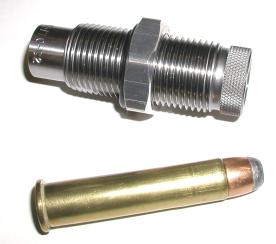
 One of my favorite sources for inexpensive non-critical shop tools is Enco. As an example, this 1 ton arbor press sells for about $28. I borrowed a 150 lb freight scale for the sake of accuracy, but I suppose I could have used a $20 digital bathroom scale. Combined, these two pieces of equipment made up my tester for measuring compression yield.
One of my favorite sources for inexpensive non-critical shop tools is Enco. As an example, this 1 ton arbor press sells for about $28. I borrowed a 150 lb freight scale for the sake of accuracy, but I suppose I could have used a $20 digital bathroom scale. Combined, these two pieces of equipment made up my tester for measuring compression yield.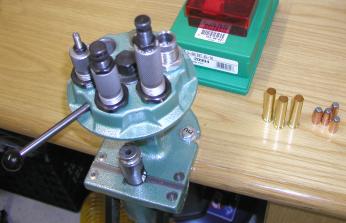
 I used the term “no crimp” on the examples that relied only on neck tension to retain the bullet. The .45-70 is a nearly straight case, so full length resizing only applies pressure inward on the case, and there is no traditional bottle neck case expander button to pull back though the formed case to set proper case mouth diameter. The second die in a three die set, is the expander die. The expander die houses an anvil that properly expands the case for correct neck tension and, if desired, slightly bells the mouth to make bullet starting easier. The third die in the set seats the bullet, and offers the option of roll crimping the bullet case assembly, or seating and retaining the bullet with only case neck tension.
I used the term “no crimp” on the examples that relied only on neck tension to retain the bullet. The .45-70 is a nearly straight case, so full length resizing only applies pressure inward on the case, and there is no traditional bottle neck case expander button to pull back though the formed case to set proper case mouth diameter. The second die in a three die set, is the expander die. The expander die houses an anvil that properly expands the case for correct neck tension and, if desired, slightly bells the mouth to make bullet starting easier. The third die in the set seats the bullet, and offers the option of roll crimping the bullet case assembly, or seating and retaining the bullet with only case neck tension.





Email Notification